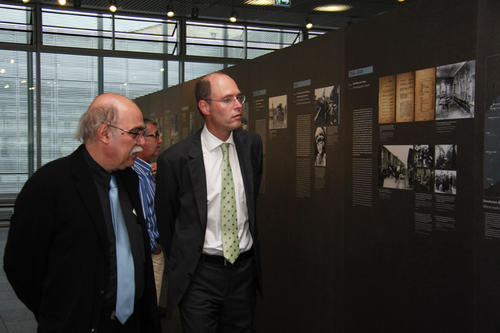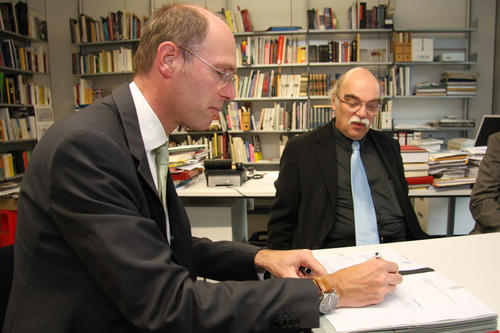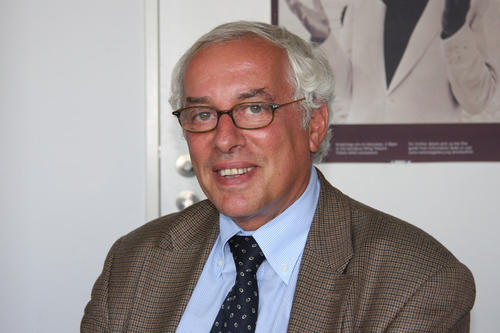Voices of Victims at the Site of the Perpetrators
Freie Universität and Topography of Terror Documentation Center sign cooperation agreement and launch joint education program
Sep 29, 2011
Professor Peter-André Alt, president of Freie Universität, and Professor Andreas Nachama, executive director of the Topography of Terror Foundation, visited the Documentation Center together.
Image Credit: Jan Hambura
Professor Peter-André Alt signed Freie Universität’s cooperation agreement with the Topography of Terror Documentation Center.
Image Credit: Jan Hambura
Professor Nicolas Apostolopoulos, director of the Center for Digital Systems at Freie Universität (CeDiS), provides the technical expertise for incorporating the digital archives intothe new education program.
Image Credit: Gisela Gross
“Voices of Victims at the Site of the Perpetrators” is the title of the new education program on the Nazi period to be developed and implemented jointly between Freie Universität Berlin and the Topography of Terror foundation. A cooperation agreement to this end has been signed by Professor Peter-André Alt, president of Freie Universität, and Professor Andreas Nachama, managing director of Topography of Terror. The goal of the project is to provide young visitors to the Topography of Terror Documentation Center with access to films of interviews with contemporary witnesses and, in particular, to give them an opportunity to examine how the victims viewed the perpetrators.
Sparked by a temporary exhibition project as part of the commemorations surrounding Berlin’s 750-year anniversary in 1987, the Topography of Terror foundation has worked since then to disseminate historical knowledge about National Socialism and the crimes committed under the Nazi regime. Between 1933 and 1945, the site that is currently home to the foundation – near the Martin Gropius Building and not far from Potsdamer Platz – was where the main centers of Nazi terror were located. The headquarters of the Gestapo were here, with an “in-house jail” of their own, along with the High Command of the SS, and, during World War II, also the Reich Main Security Office.
In addition to a permanent exhibit on the institutions of the Nazi apparatus of persecution and terror, numerous education programs held in the basement and aboveground levels of the documentation center deal with the motives and actions of the perpetrators. Now, in this location, the foundation will also make the voices of victims of the Nazi regime accessible to visitors, in the form of contemporary witness interviews caught on film.
Freie Universität is providing access to three important digital archives of firsthand witness accounts of the Nazi period: the Visual History Archive of the Shoah Foundation Institute of the University of Southern California (USC), the Refugee Voices archive of the Association of Jewish Refugees (AJR), and the Forced Labor 1939–1945 archive, which is being developed academically at the Center for Digital Systems (CeDiS) at Freie Universität. “Although no media can substitute for personal encounters with survivors and witnesses, their memories and life stories are becoming more and more important, especially in terms of learning about history,” explained Professor Peter-André Alt.
The goal of the joint education program operated by Freie Universität and Topography of Terror is to prepare the digital interviews from an instructional standpoint, making them accessible to elementary and secondary school students. “The victims’ perspective about the perpetrators is an important aspect of the education work done by the Topography of Terror foundation, which is vividly supplemented by the interviews with contemporary witnesses,” explained Professor Andreas Nachama.
By the end of this year, the partners aim to develop a joint teaching concept for the organization of daylong projects at schools, examining the acts of the Nazi regime in the context of statements from survivors. “Before, the school classes came to Freie Universität to use the digital contemporary witness archive as part of these kinds of events,” said Professor Nicolas Apostolopoulos, head of the Center for Digital Systems (CeDiS) at Freie Universität. Now, he says, the “Voices of Victims at the Site of the Perpetrators” project allows students to work with the interviews during a visit to the Topography of Terror Documentation Center as well. About 30,000 students have already participated in special guided tours of the center.



